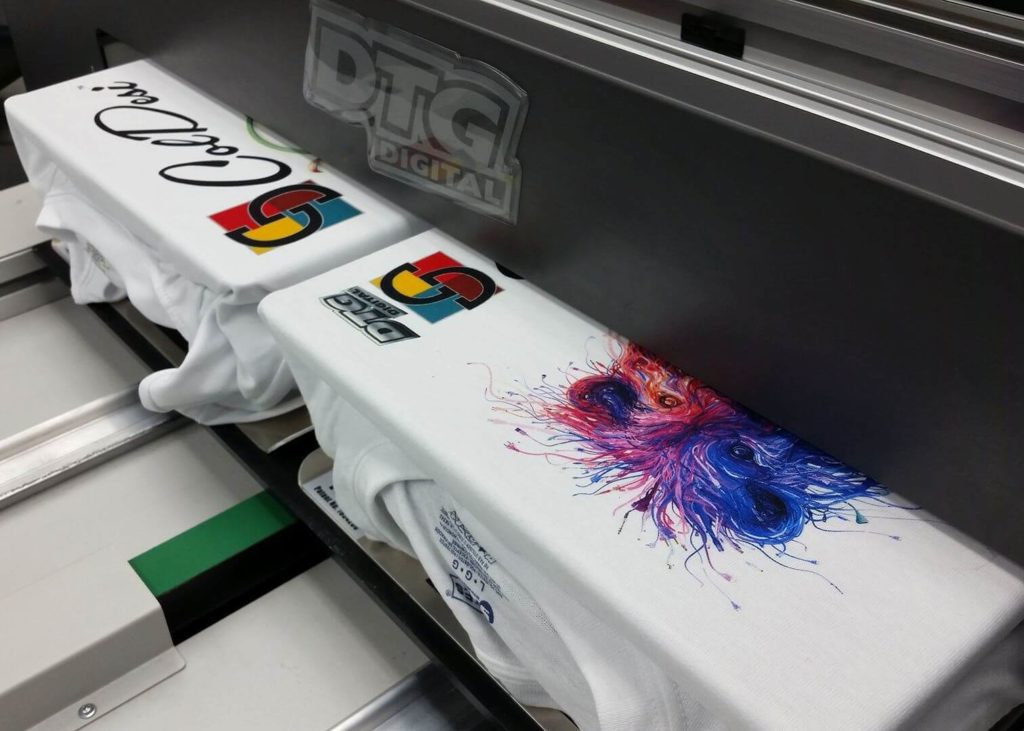SCREEN PRINTING
One of the oldest printing methods, the screen printing approach, impels the ink through a screen that is mounted on a frame and has a design or stencil attached to it. Owing to the method used, this tactic is employed when a single colour is to be used at a particular time, thus limiting the variety of hues that can be used on a t-shirt. Apart from more investment, each design calls for a different screen and stencil. Screen printing proves cost-effective when the desired designs are simple and/or demand a sole colour or when the insistence for one particular design is greater.
Direct to Garment (DTG)
A relatively recent invention compared to Screen Printing DTG or Direct to Garment printing also known as Digital Garment printing, Digital Apparel printing, and Inkjet to Garment printing, utilizes a printer to squarely print onto the garment in the form of the necessary design. DTG wields a special kind of ink that is absorbed by the fabric of the garment.
Since DTG is a more technologically advanced system, this is more expeditious. The degree of precision availed is greater than that of Screen Printing and further, the graphics produced as an outcome, have all their details maintained. Printing a solo item or a bulk, the quantity is never a problem for DTG. Also with no restriction on the usable number of colours, DTG allows customization, with absolutely zero hindrance.
To give its customers the best T-shirt experience, oowia employs the advanced DTG method to bring the graphics alive. Although the setup is quite expensive, for example, the machine used by oowia costs roughly around 1.25 Cr in India and with a low turnaround of 3 t-shirts per minute, the benefits of DTG are several:
- Allows printing on a hundred percent cotton t-shirt along with other platforms like on tote bags, jerseys, hoodies, vests and zippers.
- The inks used in a DTG machine are water based, thus absolutely eco solvent. Often we also use vegetable dyes, which apart from being eco solvent are also completely organic and herbal in nature.
- There is no wastage, as each and every t-shirt we ship out is freshly created just for that particular order. Thus all we stock upon are the raw materials and not the end products.
- The colour range of the machine we use is 16 million. A design on a oowia t-shirt can have just one or all of 16 million colours on a single t-shirt.
- Print longevity is exceptionally high. Any of our normal t-shirts can easily withstand around 70 washes, thus making it last for 1-2 years at the least!!
- The graphics are quite crisp and detailed. Every solid colour is printed in its desired form and not in half-tone dot print fashion.
DYE SUBLIMATION
A digital printing technology, for the Dye Sublimation process, the images are first printed on coated heat-resistant transfer paper used as an altered image of the final design, which then gets imbued onto the polyester fabric in a heat press, operating at a temperature around 180 to 210 C (375 F).
Thus the image to be printed is engaged on polyester cloth, with three pre-requisite ingredients: sublimation ink, pressure and heat.
Sublimation ink has a distinctive quality of being able to transform directly from its solid to a gaseous state, without having to undergo the liquid state. Initiated by heat, this change can be regulated by monitoring the time and pressure enforced.
Affordable and widely used, Dye Sublimation comes with its own limitations, enumerated below:
- Only complements polyester garments or at least a blend of poly and cotton with 60:40 ratio.
- Dye Sublimation renders itself well, on light or just white garments.
- Hardly durable, graphics made using the dye sublimation process can endure only up to 5 or 6 washes.


